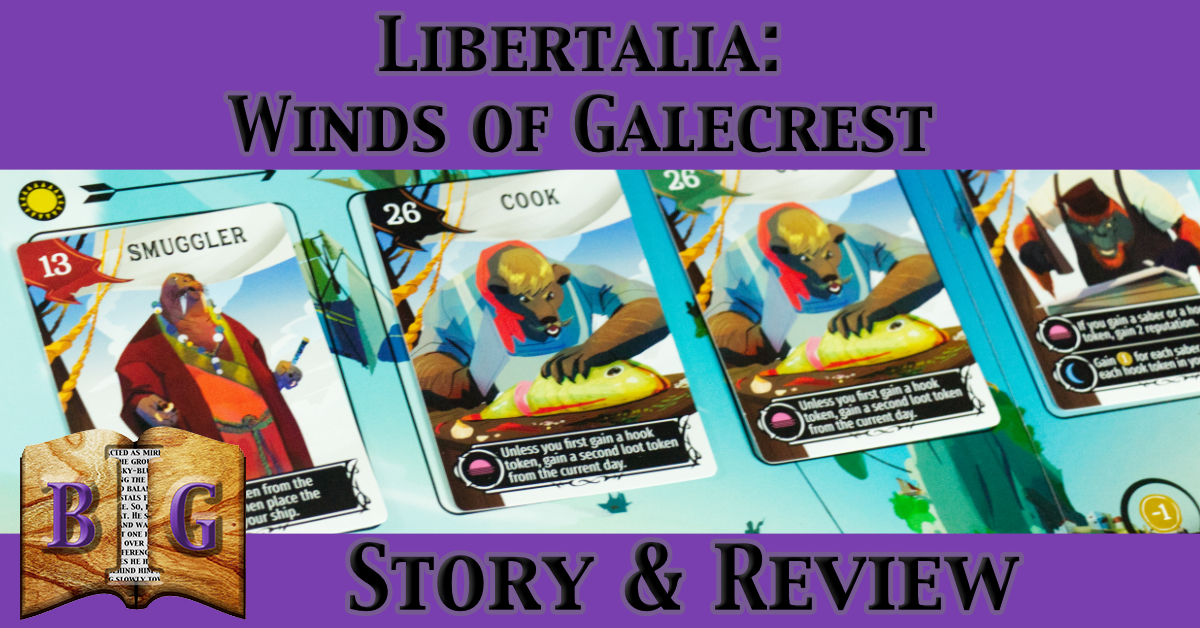Note: I was provided a complimentary copy of Libertalia: Winds of Galecrest for the purpose of review. The thoughts and opinions in this review are my own.
At a Glance — Libertalia: Winds of Galecrest
Year Published: 2022
Designer: Paolo Mori
Publisher: Stonemaier Games
Artist: Lamaro Smith
Player Count: 1-6
Editor: N/A
Suggested Age: 14+
Playing Time: 45-60 minutes
Theme: Pirate, fantasy, air ships
Mechanisms: Action queue, hand management, simultaneous action selection, set collection
Find more about Libertalia: Winds of Galecrest by visiting Stonemaier Games online on Facebook, Instagram, and their website!
“Fortune prick me.”
― Bayle Domon, as written by Robert Jordan in The Wheel of Time
Libertalia: Winds of Galecrest Intro Story: Story Title
The seas may dry up and the forests turn to ash. But the sky will always exist.
That was the mantra of Skyhawk‘s captain. She frequently repeated those words for comfort. In Galecrest, sea-faring pirates and merchants were a thing of the past. Today, with magic only discovered within the past few decades, “trade winds” have taken on an entirely new meaning. Soaring in her ship, Maylene smiled as her crew performed their duties diligently. Her smile broadened even more when the image of an island began to form off on the horizon. They were almost there.
Unfortunately, as the Skyhawk drew closer, she noticed other ships ploughing through the gusty sky. So, others had also heard of the fortune left behind. Well, with her crew’s experience, Maylene was confident she would make off with the most of the loot. She barked out a few orders to her crew as she settled her ship on the sandy beach.
She selected some of her brightest crew to join her: the cook, the scout, the brawler, the witch, and the bosun. Perhaps others would have brought a different crew along for the journey, but Maylene knew her crew, and these were the ones she trusted for the job at hand. As they ventured forth deeper into the island, however, something caught her attention.
The other pirate groups, also led by their captains, brought the same crew as she had. Maylene hadn’t known that other factions had witches with them, or would even consider bringing along their cook. As it was, each captain eyes the others, wary as to what this foreboding omen meant. Well, one thing was for sure—they may all have the same crew at their disposal, but Maylene certainly knew how best to use their skills to their maximum potential.
And she would make any sacrifice necessary to come out on top.

Overview/Roadmap
This review has two parts. First, there is the Short Review, where various aspects of the game are discussed. Then comes the Gameplay Review, in which the setup and gameplay are discussed in detail, along with initial thoughts. Following the Gameplay Review section are some final thoughts and a final verdict of the game. Feel free to jump around, or read it all in one go.
Libertalia: Winds of Galecrest — Short Review

There’s a lot to be said about a game that has players take all the same cards in their hands—each with the same abilities, numbers, etc.—and tell them to make their hand win them loot. It doesn’t sound reasonable! And yet, despite all players in Libertalia: Winds of Galecrest playing each round with the exact same cards, the games are wildly thought-provoking, simply intelligent, and downright fun.
Of course, there are other aspects at play, such as turn order (i.e. reputation) and out-thinking your opponents, but the fact that the game’s mechanisms are so simple yet so complex is an intriguing aspect of the actual game itself. I enjoy playing it, since all games end up completely different from the last. Seriously, it’s a lot of fun. But is it the best Stonemaier game yet? Well, you be the judge after reading this review.
Immersion
There’s a lot of immersion happening in Libertalia: Winds of Galecrest. Mostly, this immersion comes through playing various crew cards (pirates! Arrrr) and using their thematic abilities as best as possible. The art, too, helps with the immersion factor, but perhaps the thing that really makes the game immersive is that all players must be constantly thinking about what their opponents want to be doing each round, and trying to outthink them. Getting that brain working in that manner somehow invests you in a game that other mechanisms simply can’t replicate.
Theme

The pirate theme is quite apparent from the get-go, and the use of animals as crew makes the theme fun and a little more lighthearted than if it were more realistic. The crew abilities fit the theme, and the loot tokens and money/treasure chests certainly fit the theme.
While the theme officially has the pirates in airships, there is little—if anything—in the gameplay to suggest that these things are possible. Still, it’s a nice touch and it looks nice on the box, so I’m happy with it. Maybe an expansion will hit on the airships. Time will tell.
Art & Components

The art is lovely. I mean, it’s bright and vivid and does a fantastic job of showing us around this world of Galecrest. After playing this version a number of times, I went to Board Game Geek to check out the original version. While there was certainly nothing wrong with the art of ye auld version, it was more along the lines of a gritty, realistic pirate theme. That’s fine and dandy and all, but I, personally, love the more fantasy version Lamaro Smith created for us in Stonemaier’s version.
The components are great. The cards are cards (nothing special there), but the board is beautifully illustrated and the loot tokens are nice bakelite quality. And shiny, too!
Standout Performances
- Impressive solo variant
- Impressive two-player variant (with no extra work for players)
- High-quality loot tokens
- Double-sided board (and tiles) for more variance
- Lovely art
- Simple rules with a good amount of depth for all types of gamers
Breaking the 4th Wall
In theater, breaking the fourth wall refers to when characters (or something else) directly address the audience, thus pulling them out of the narrative and making them astutely aware that they are, in fact, watching a performance and that’s it’s not actually real.
Libertalia: Winds of Galecrest shines with more players. However, there are some modified two-player rules which help simulate a third player. Personally, I enjoy the two-player variant just fine. I will say again, though, that Libertalia is at its best with more players (so everyone is getting in everyone else’s way). It’s a small thing, but something you two-player people may want to consider. So far, my wife and I have played it two player a few times and it has always been a fun and engaging experience. So there’s that.
One complaint I could see emerging from Libertalia is reorganizing the card deck after each game so it’s ready for the next session. You see, each deck should remain in numerical order—save one, which is shuffled. The shuffled deck reveals the six cards used in each round, and the other players find those numbers in their own decks. After the game, cards need to be returned to the deck in numerical order so the next time you play, it will all be ready. Not a big deal, if you ask me (it doesn’t take too long to organize), but some may not be a fan. However, one Board Game Geek user (and I lost the thread, so I don’t know who it was) created a random card generator that selects the cards for you each round. So if you want to avoid shuffling all the decks, give that a try.
Libertalia: Winds of Galecrest — Gameplay Review

First Impressions
Maybe I’m special, but at first, the rules seemed confusing. However, after a round, I was able to grok what was happening, including strategy and the like. It’s mostly the order of operations that confused me, but once I got that down, the game flowed like the Boyne. Likewise, it took my wife about half the first round to catch on. And for those in my game group? Well, they seem to get everything quickly, so more power to them.
So really, even if you’re not sure about the gameplay, give it a try and I bet you two hook tokens and an amulet that you’ll catch on quicker than a cannonball flies through the broadside of a barge.
Setup

Setup is relatively simple. First, lay out the board (sunny-side up or stormy side—you pick; although sunny is the regular variant). Populate the first four days (indicated on the board) each with one loot token per player. Everyone gets randomly assigned a starting reputation (which also dictates starting money), takes a deck of 40 cards, takes a treasure dial (i.e. treasure chest), and get your graveyard tile. Assign one person to shuffle their deck—nobody else shuffle! Please, don’t shuffle. The person who shuffled draws six cards and calls them out to everyone so they can search their own decks and pull out the exact same cards that the shuffler drew. Take your starting money (indicated under your influence token’s position) and get ready to plunder!
Gameplay

Each “day,” players select a card from their hand and play it face down. Once everyone has selected their card, all cards are revealed and placed in ascending numerical order on the board. Of course, there’s a 110% chance that at least one other player will select the same card you did, so whose card goes where? That’s where reputation comes in. If you have higher reputation than the other player(s), then your card goes to the right of the other cards of the same value.
So, once all the cards are nicely aligned on the board, starting from left to right, players activate their cards’ daytime abilities (the one with the sun on the card). The lower your card’s value, the sooner yours will activate. Pretty cool! But once we get to the end of the row, then it starts from the far right and goes back down. This time, all dusk abilities are activated and, if the player’s card still exists on the board (i.e. island), they can claim a loot token from the current day. Once a player has taken their loot, they move their crew card to their “ship,” which is essentially the play space directly in front of them (some cards have ongoing abilities that activate every night, or one ability that activates at the end of a voyage). And then so on and so forth down the line until everyone has collected the day’s loot. Or not, abilities depending.
If the loot token you took has a dusk ability (it will show what phase it activates in on the board), it activates when you take the token. Otherwise, wait until night (after all players have activated their dusk abilities or until the voyage is complete (the anchor icon). Some card abilities remove other players’ cards from the island before theirs can activate or claim a loot token, so positioning is very important. I’ve gone an entire journey where I only got one or two loot tokens the entire trip. That’ll teach me to play smarter!

Once all night abilities have been activated, a new day dawns and players select another card to play. Once all the days have passed (you populate each day with loot tokens at the start of the journey, so once the last day is depleted of tokens, you know the journey is about to end), activate any anchor abilities on loot and/or characters, and count your money. Using your treasure dial (that looks like a treasure chest), input your current money value. Then return all your money and loot tokens back to their supplies, and the crew cards in your ship…well, they die an agonizing death, so put them on the graveyard tile. Wherever your reputation token is dictates how much gold you start the next round with. The lower the reputation, the more money, so there are perks to being vile lowlife.
There are three journeys in total, the first taking four days, the second taking five, and the final journey taking a whopping six days. You are limited to the cards in your hand at the start of each round, and any cards you didn’t use on previous rounds remain in your hand. In this way, players start having (slightly) different hands than their opponents, creating additional drama on the high seas! Er, high winds, I guess, since these pirates travel by airship.
Thoughts on Gameplay

The gameplay is robust, with each game different than the last, since crew cards and daily loot tokens change from round to round and from game to game. It’s a lot of fun predicting what your opponents are going to do (and then getting it inconceivably wrong). The card abilities and activations make for both short- and long-term planning, and it’s wonderful to see your plans come together. It’s also inevitable that your plans will be dashed against the rocks below, but hey! That’s the life of a pirate for ya.
Over all, I’ve really enjoyed each session of Libertalia I’ve played. If you’re dealt a bad hand, it’s okay, because literally everyone else is dealt the same cards. It’s all about what you do with what’s dealt to you, which is where a good portion of the fun comes from.
I will also mention there are some modified rules for a two-player game, which includes using the Midshipman board. The Midshipman’s number is 20.5, and kind of simulates a third player. Players don’t have any additional upkeep with this modification, but crew cards directly to the left of the Midshipman activate the Midshipman’s dusk ability, which allows that player’s opponent to select and discard a loot token from the current day. This can either help or hurt you, depending on which player’s crew card occupies the spot next to the Midshipman. It’s an intuitive way to simulate a third player without requiring an extra deck or any other upkeep. And I will say that while I really do enjoy playing Libertalia at two players, it does shine with even more players. So that’s something to keep in mind.

Solo Play

As in typical Stonemaier fashion, Libertalia: Winds of Galecrest includes a solo variant. How can a game that requires out-thinking your opponents even work with one player? Well, it does. There are essentially two automa players: the actual opponent (who collects money and reputation and stuff) and the Pilferer (who essentially blocks you from the best loot tokens). The backs of the automa cards show you what your automa opponent will play based on the loot tokens available for that day. It’s a simple system, really, although I had to look at the reference sheet for the first full voyage. After that, though, it came naturally.

I actually really enjoy this solo. Sure, it plays best with more, but when I want a fix and it’s just me, the solo variant simulates a second and third player quite nicely. Once again, I am impressed with the way the automa works to create a solo variant that isn’t an afterthought, but a fully fleshed-out system that quite accurately simulates two additional players.
Libertalia: Winds of Galecrest — Final Thoughts

When it comes down to it, I’ll always enjoy playing Libertalia: Winds of Galecrest. It’s a fairly quick play, the choices are interesting, and setup is pretty quick. The biggest downside is that it practically begs for more players. That said, the alterations made for two players is more than sufficient to get the job done, and the solo variant is uncannily similar to a three-player game. Libertalia is fun, and its mechanisms aren’t seen in a lot of other games, which adds to the appeal.
Final Verdict
Without any additional preamble, I will jump right into the final verdict and give Libertalia: Winds of Galecrest a rating of Two Thumbs Up. Honestly, I think it’s just shy of being Two Captivating Thumbs, which in large part comes from the need (more or less) for more players to really get what this game is all about. Still, it’s a solid game with loads of variation from game to game (and game to game to game…).
Verdict Scale (Lowest to Highest)
The Final Verdict is based on a scale of 1-7, although this scale is not numbered. Instead, it uses thematically appropriate words to describe the performance of the game.
Tomatoes – This game was emotionally taxing and difficult to finish.
Uninspiring – This game had me daydreaming about other games.
Lackluster – This game had its moments, but it probably won’t see much table time.
Laodicean – This game is decent. It works. There’s a reason people like it.
Two Thumbs Up – This game is pretty dang good.
Captivating – This game is outstanding! It’s more than good; it’s practically a staple.
Standing Ovation – This is the best game you will ever play. Period.
Read short fiction inspired by board games at BGI’s stories page!
Visit Stonemaier Games on Facebook, Instagram, Twitter, and at their website.



